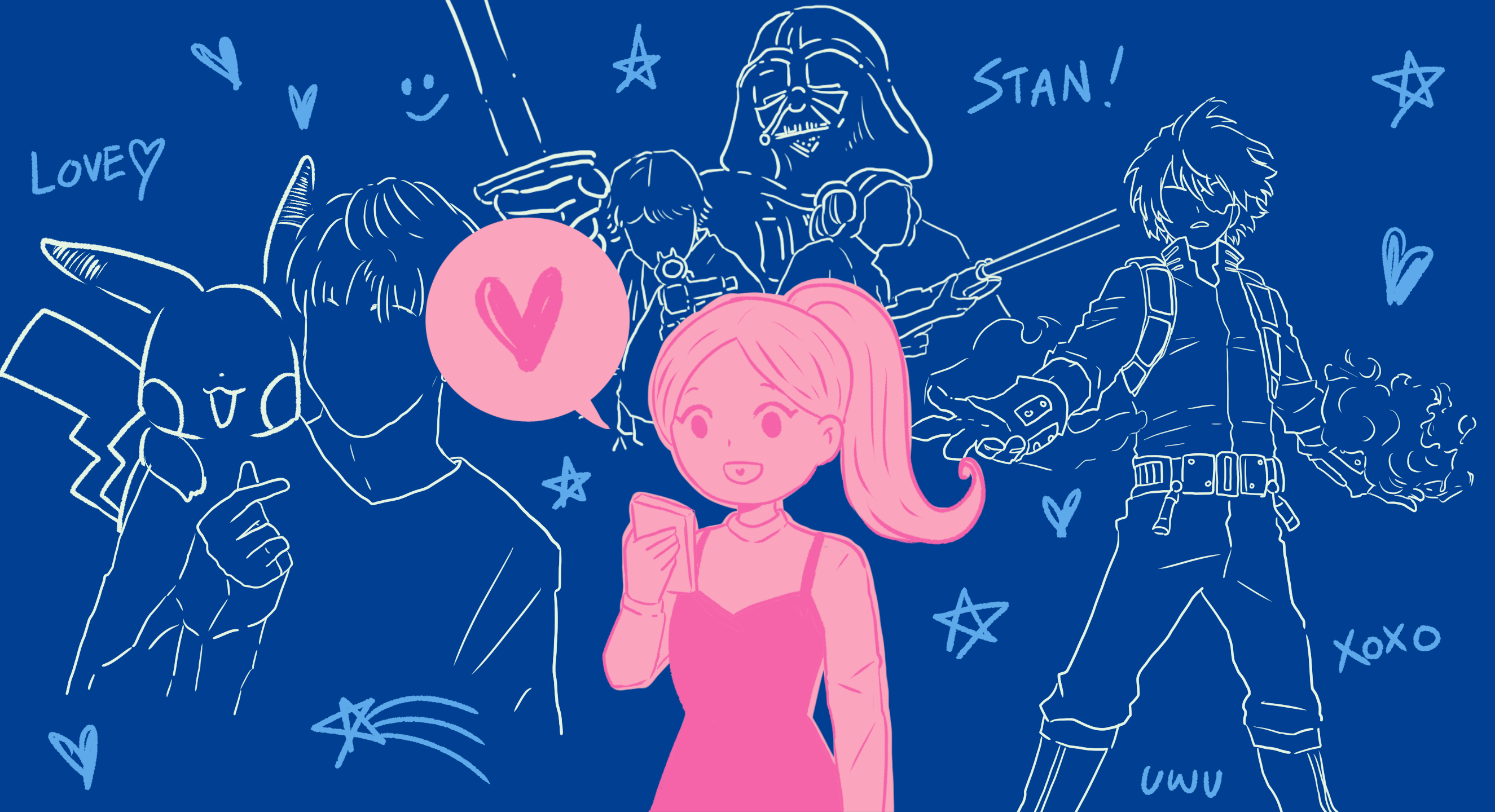For these Ryerson students, fandom became a gateway into creative degrees and careers
By Jack Wannan and Abeer Khan
Visuals by Heidi Lee
In 2013, Jillian Maniquis, alongside a few of her online friends, planned a fan project for Cody Simpson’s upcoming concert. They printed over 500 posters to hand out to fans at his show at Massey Hall in Toronto. The posters read, “So Much More Than Cody Simpson,” an opening lyric in one of his earliest songs, One. They placed the posters on seats around the venue, with instructions on the other side telling fans when to hold the posters up. They also handed them to attendees individually as they trickled in. As she gave out posters fan by fan, she’d hear people ask, “Are you Jillian? TheCodySociety? I follow you on Twitter, my handle is…”
Coming from a low-income household in North York, it was rare for Maniquis, who graduated from media production last year, to have opportunities like this—to go to concerts or buy merchandise—and she was too young at the time to secure a job. Twitter became Maniquis’ way to connect with Simpson and his fans. She maintained TheCodySociety, a fandom page on Twitter for Simpson, which she first created at the age of 12 on her family computer. She would use the account at home and at school on her LG Neon flip phone. Since the phone didn’t support apps, she had to text Twitter’s “40404” number to get tweets out.
The account amassed thousands of fans who followed her to get updates on the artist and it became one with one of the highest followings for a Simpson fan account in Canada. She remembers Warner Music Group reaching out to her, telling her they recognized her work and receiving messages from Simpson’s management asking her to tweet out events he’d be participating in. She even joined the singer-songwriter’s street team and helped with promotional activities at the age of 15. In return, she sometimes received free merchandise and concert tickets.
Maniquis was also one of the only people of colour within the fandom with such a large following. She recognized early on she didn’t have the same privileges as her white and higher-income counterparts. She says she always felt a bit out of place, especially when other fans would talk about going to five shows over the course of two weeks. Meanwhile, Maniquis could only go to one show. “And it was a really big struggle for me to pay for that.”
Her participation in the Simpson fandom allowed her to make friends and further discover her passion for content creation. It also allowed her to meet other fans who she otherwise wouldn’t have connected with. “For many of us as teens, [Cody Simpson] was a connection needed to make these friendships, to feel like we were part of a community,” says Maniquis. “We were proud of how far he came, but I think in hindsight, it was also a celebration of how far we’d all come alongside him.”
During that concert, when Simpson started playing Summertime Of Our Lives halfway through his set, Maniquis saw everyone in the venue raising the posters she and her friends had handed out before the show. She remembers Simpson looking around the room in awe. She says it was one of those “I made it” moments. When the song ended, roars echoed throughout the hall and she looked at her friend, screaming “We did it! We did it!”

Fandom, a term used to describe enthusiastic fan bases, provides an outlet for fans to go beyond the surface level of consuming and enjoying their favourite forms of entertainment. Fandom has fuelled a way for audiences to discuss and build upon their favourite musicians, artists, movies, shows and more, while connecting with others who share similar interests.
Rhiannon Bury, a women’s and gender studies professor at Athabasca University in Alberta and a fan studies scholar, says fandom can be characterized by two critical components. First, the fandom must be organized around a specific person or object of affection, whether that be a TV show or musician. Second, fandom also has to involve interacting with other people outside of one’s normal social circle.
Bury says people join fandoms to be a part of something bigger than themselves and to find communities outside of their everyday lives. “Fandom just happens to hit some of the buttons to connect with other people who have similar ideas,” says Bury.
Within these fandoms, Bury says fans form “fan communities” where they’re clearly and regularly connecting with a group of people. “These communities can involve creative work, like producing fan fiction, videos and sharing those among the community,” says Bury.
For some Ryerson students, the art and content that they produced within fandoms started out as a way to become more invested in the community. As time passed however, their fandom-inspired activities became gateways into creative careers that they’re now pursuing within their post-secondary education and beyond.
This is known as participating in the activity of cultural production, first discussed by British cultural theorist Angela McRobbie. In her article, “Shut up and dance: Youth culture and changing modes of femininity,” Robbie says this participation provides “the opportunity of learning and sharing skills, practicing them, making a small amount of money and more important, they provide pathways for future ‘life skills’ in the form of work or self-employment.”
Fandoms help teach skills that are marketable, says Jessica Yang, a PhD student at the University of Southern California who is studying the intersection of YouTube and fandom. “Fandoms help incubate talents and skills that can then be very useful in future careers,” she says.

oughly a week after Star Wars: The Force Awakens made it to theatres in 2015, Gabriella Rigakos and her family packed into the Courtney Park Cineplex in Mississauga, Ont. to see the newest addition to the series. By then, the box office hit had already made over $400 million USD worldwide and some diehard fans had already seen the movie not once, but twice. Rigakos, though, was certainly not a diehard—yet.
As she sat down in the theatre, she was particularly interested in seeing Rey, the first woman character to lead in a Star Wars film. But Rey wasn’t who was on her mind when she left the theatre that night. Instead, it was the villain, Kylo Ren, who had revealed his face for the first time in the film. When he took off his mask, Rigakos sat in awe, watching the action unfold. There was something about seeing his character’s face revealed for the first time that will forever stick with her.
“I was just the most starry-eyed 13-year-old in the room,” Rigakos says. She spent the car ride back from the theatre wondering, “Why do I care about him?”
Rigakos’ love for Kylo Ren is hard for her to explain; after all, he is the villain of the story and hated vehemently across the Star Wars fandom. But for her, Kylo Ren was more complex than just a villain and to write him off as such wouldn’t be doing his character much justice. “I don’t relate to this person because he wants to blow up a planet, I relate to him because he doesn’t know what to do with his emotions,” she says.
After watching the movie, Rigakos watched every Star Wars film, show and spin-off the franchise had to offer. However, this content wasn’t enough for her; she wanted more. This is when Rigakos decided to venture into the world of fandom, where she was able to get more into the franchise. She downloaded social media platforms like Tumblr and Instagram in hopes of connecting with other fans who felt the same way she did.
Soon, Rigakos found herself immersed in the ‘edit’ community, which consisted of fans who would edit video clips from their favourite shows. She was introduced to the format by a Star Wars fan in Greece, who FaceTimed her and offered lessons on Adobe AfterEffects. The fan taught her how to use the app, not for money or some type of shoutout, but simply because she had a passion for fan-edits and wanted to pass her wisdom along.
She became a part of a large edit community online where she posted countless Star Wars edits, including those of Kylo Ren, sometimes ‘shipping’ him with Rey. She became a fixture in a community of editors, and she even met one of the fans she connected with online at Toronto Comicon.
Years later, Rigakos’ experience making edits of Star Wars characters and other film stars has led her to a much more serious pursuit: getting her undergraduate degree in film studies at Ryerson University.
The popularity of fan-made art has been coined as participatory culture by American scholar Henry Jenkins, who says in his book Textual Poachers that “fans [form] alternative interpretations that were often expressed through unauthorized cultural productions.”

Many fans start to create art due to their intense love for a fandom. A 2013 study in the Journal of Adolescent & Adult Literacy that looked at movie series The Hunger Games, internet game Neopets and PC game The Sims, determined that being in a fandom accelerates productivity for some artists, claiming that once fans become invested in a fandom they often take on more participatory roles within them.
Fandomhood has become more accessible than ever as individuals gain greater access to the internet from a younger age. Bury says fan culture was “very localized” in the 1990s, with conventions and comic book stores being some of the limited ways in which fans would interact with each other. As the internet became more accessible in the 2000s, forums or blog sites like LiveJournal allowed for fans from around the world to interact.
Fast forward a couple of decades, a large portion of the population can now access a fandom of their choosing with the touch of a phone, tablet or laptop. “Arguably fandom is accessible to anybody and everybody with a digital device,” says Yang.
However, while she says social media has made fandom more accessible, some fandoms have become more closed off—it’s harder to become a part of these spaces without knowing proper slang or lingo that you would need to search to find what you’re looking for. “It then becomes a question of do you have the insider know-how to actually navigate and get to that point?” says Yang.
Today, Rigakos is no longer the Star Wars fan she once was. As a film student, she’s been exposed to other genres and styles of film, opening up a whole new world for her to explore. But every once in a while, she likes to look back at that time in her life and reminisce.
During the pandemic, trapped in her room and looking for things to do in the early stages of lockdown, Rigakos found herself going back to the roots of her fandom history. Surrounded by walls with posters that are a mixture of official merchandise and fanart—including Steve Rogers and Bucky Barnes from the Marvel Cinematic Universe, and eons of Star Wars memorabilia she’s collected over the years—she found comfort in what she once loved, especially Star Wars.
At least for a short period of time, the films and culture surrounding the series sucked her back in. “I did start editing a little more again,” she says. In retrospect, she recognizes that she wouldn’t be where she is today without that time she spent as a fan. The edit community often created an environment where people were uplifting, teaching and competing with each other, pushing many to produce high-quality work. For Rigakos, the community pushed her to take her work seriously, and explore it beyond the confines of Star Wars.
“I realized I can actually do this for the rest of my life.”

t 12-years-old, Cindy Phung, now a third-year performance student at Ryerson, was frantically searching for some kind of escape from her everyday life. As an introvert, she grew up spending a lot of time in her home in Brampton, Ont. by herself with hours to kill. With her older sister off at university and her parents out of the house working until early evenings, there were large gaps of time in her day she was desperate to fill. She remembers grappling with an “existential” feeling of understanding of the reality around her; her life often felt underwhelming. As she found a place in fandom however, this feeling shifted. “Being able to just shut off for a minute and go into a bigger world, where the possibilities feel endless, just felt safe,” says Phung.
Phung would often escape from reality and into the Doctor Who and Merlin universes, a couple of popular sci-fi and fantasy TV shows. Thoroughly entrenched in both shows, Phung made an Instagram account where she would post about both shows and interact with other fans, reaching around 1,000 followers. She was drawn to the shows because of their worldbuilding and how an entire universe could be constructed through the production process of a show. This is also what attracted Phung to the fandom culture that surrounded these shows. Discussing the shows and sharing content related to them allowed her to further indulge in the universe.
Phung eventually left the two fandoms, citing their taxing nature. She says posting started to become a chore instead of a hobby. She often grappled with her intentions of running the page: was the focus on gaining a following and getting big? Or was the priority to simply just post about her favourite shows? She confronted herself with these questions often and the work she was doing for her account became more demanding. With high workloads and no pay, it was taking too much time out of her day.
However, Phung says her time in fandom is a big reason why she’s so involved with art and production these days. She says it propelled her into her pursuit of exploring theatre. “The possibilities were endless, I could do whatever I want in theatre, I could do whatever I want in film. And it was just so much fun.”
For nearly everyone involved in fandom culture, profit isn’t a motivator for their work. Social status within a fandom is often attractive to some, but for many, their motivation comes from simply wanting to contribute to the fandom. The idea of this work is known as the “gift economy,” where fans produce art without the goal of making money, according to a 2020 article published in Television and New Media. Instead, the payment is that they are working in a community of others who will also supply art, creating a system where everyone can create and consume fan-made content.

However, being involved in fandom can also be profitable. Bestselling book-turned-movie Fifty Shades of Grey notably started out as a Twilight fan-fiction before becoming a billion-dollar franchise in novel and movie form. The erotic fiction series is a notorious example, although it isn’t a fair representation of most fandom work, which is appreciated in small circles that don’t often see any monetary return.
Fatigue from fandoms is also not unheard of, especially when it comes to social media, where there’s greater pressure put on fans to create content and stay online, especially as their social media presence grows. “It becomes a high-pressure thing, the more successful you get, the better you do, the harder it is on you,” says Andrew Deman, an English language and literature professor at the University of Waterloo.
Being in fandoms for Doctor Who and Merlin, Phung found herself in spaces that were predominantly white. Not only were the casts of the shows mostly white, but it was clear to her that the fandom was that way as well, as there was a lack of conversations around race and diversity. Whether it was intentional or not, she thinks her interest in the show Merlin was, in part, due to one of the characters, Guinevere Pendragon, who was played by a woman of colour.
During her time in the fandom, Phung says there weren’t many discussions about the lack of representation in the shows she watched. That’s not to say fandoms weren’t engaged in discussing social issues at all; she remembers many accounts having discussions about LGBTQ+ representation on shows. Phung would also use her account to discuss issues on her mind outside of fandom.
A 2020 report from the UCLA College of Social Sciences found that while representation in entertainment has been trending toward more inclusion of Black, Indigenous and people of colour (BIPOC), they continue to be “underrepresented on every industry employment front.” The study found that racialized people held only 24 per cent of lead roles on TV shows, with 35 per cent represented lead characters in cable scripted shows like Doctor Who and Merlin. In Canada, racialized people represent just 16 per cent of speaking roles in the TV industry, according to a 2016 study from Nordicity consultancy group.
The lack of BIPOC representation in the arts industry is part of what made Phung join the performance production program at Ryerson. Along with a passion for arts and entertainment, Phung wants to bring more representation to the table as well, because the shows she used to watch were “just a bunch of white people.” It was really hard for her to find TV shows and other media in which she could see herself.
Now in her third year, Phung is striving to represent what she wants to see in theatre. While the lack of representation in the industry originally made her hesitant to pursue her career, it’s now a big part of why she’s in the field. “I want to see something else because the same couple of actors keep being recycled through,” she says.

oday, Maniquis’ work within fandom is intertwined with many aspects of her life. For her final project of her degree, she produced the documentary #fangirl which follows four former and current Simpson fans. In the doc, these fans, including Maniquis, reflected on their experiences as fans, their involvement in Simpson’s promotional team and how fandom shaped their lives.
Maniquis is now a digital coordinator at the Chang School of Continuing Education at Ryerson University, where she utilizes her knowledge of social media—ingrained in her mind during her fandom years—to help market the school. Everything from the way she speaks to viewers to the tone she uses to write and the style of slipping promotions into social media posts all come from her work with TheCodySociety. But now, she isn’t representing her favourite artist on a small scale, she’s representing an entire school on a global standing. “I just knew how to do it with practice as I was a teenager…it really kind of set me up for success.”
She’s also taken her passion for fandom to TikTok where she creates videos providing commentary and thoughts on popular culture, and analyzes fandom from the lens of a woman of colour. “I’ve always been interested in fandom, but I’ve never felt like my voice mattered, especially as a woman of colour,” says Maniquis.
Her TikTok, which has over 7,000 followers and over one million likes, is where she’s able to talk freely about her opinions on all things fandom while also providing a space for women of colour to talk about and represent their experiences.
To Maniquis, how women function in society and their perspectives are often ignored by male-dominated society. Fangirls are seen as delusional or as girls who are lame and don’t have any power. In reality, however, Maniquis knows they can take on anything.
“Wait until they grow up and get to rule the world.”
With files from Sama Nemat Allah










Leave a Reply